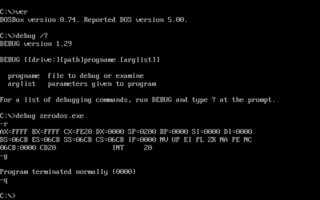
In computer data storage, drive letter assignment is the process of assigning alphabetical identifiers to volumes. Unlike the concept of UNIX mount points, where volumes are named and located arbitrarily in a single hierarchical namespace, drive letter assignment allows multiple highest-level namespaces. Drive letter assignment is thus a process of using letters to name the roots of the "forest" representing the file system; each volume holds an independent "tree".

COMMAND.COM is the default command-line interpreter for MS-DOS, Windows 95, Windows 98 and Windows Me. In the case of DOS, it is the default user interface as well. It has an additional role as the usual first program run after boot, hence being responsible for setting up the system by running the AUTOEXEC.BAT configuration file, and being the ancestor of all processes.

The cd command, also known as chdir, is a command-line shell command used to change the current working directory in various operating systems. It can be used in shell scripts and batch files.

In computing, dir (directory) is a command in various computer operating systems used for computer file and directory listing. It is one of the basic commands to help navigate the file system. The command is usually implemented as an internal command in the command-line interpreter (shell). On some systems, a more graphical representation of the directory structure can be displayed using the tree command.
In computing, the working directory of a process is a directory of a hierarchical file system, if any, dynamically associated with each process. It is sometimes called the current working directory (CWD), e.g. the BSD getcwd function, or just current directory. When the process refers to a file using a simple file name or relative path (as opposed to a file designated by a full path from a root directory), the reference is interpreted relative to the working directory of the process. So for example a process with working directory /rabbit-shoes that asks to create the file foo.txt will end up creating the file /rabbit-shoes/foo.txt.
CONFIG.SYS is the primary configuration file for the DOS and OS/2 operating systems. It is a special ASCII text file that contains user-accessible setup or configuration directives evaluated by the operating system's DOS BIOS during boot. CONFIG.SYS was introduced with DOS 2.0.

In computing, more is a command to view the contents of a text file one screen at a time. It is available on Unix and Unix-like systems, DOS, Digital Research FlexOS, IBM/Toshiba 4690 OS, IBM OS/2, Microsoft Windows and ReactOS. Programs of this sort are called pagers. more is a very basic pager, originally allowing only forward navigation through a file, though newer implementations do allow for limited backward movement.
Long filename (LFN) support is Microsoft's backward-compatible extension of the 8.3 filename naming scheme used in DOS. Long filenames can be more descriptive, including longer filename extensions such as .jpeg, .tiff, .html, and .xhtml that are common on other operating systems, rather than specialized shortened names such as .jpg, .tif, .htm, or .xht. The standard has been common with File Allocation Table (FAT) filesystems since its first implementation in Windows NT 3.5 of 1994.

The line-oriented debugger DEBUG.EXE is an external command in operating systems such as DOS, OS/2 and Windows.
Computer hardware or software is said to be bug compatible if it exactly replicates even an undesirable feature of a previous version. The phrase is found in the Jargon File.

In computing, ATTRIB is a command in Intel ISIS-II, DOS, IBM OS/2, Microsoft Windows and ReactOS that allows the user to change various characteristics, or "attributes" of a computer file or directory. The command is also available in the EFI shell.

In computing, type is a command in various command-line interpreters (shells) such as COMMAND.COM, cmd.exe, 4DOS/4NT and Windows PowerShell used to display the contents of specified files on the computer terminal. The analogous Unix command is cat.

In computing, del is a command in command-line interpreters (shells) such as COMMAND.COM, cmd.exe, 4DOS, NDOS, 4OS2, 4NT and Windows PowerShell. It is used to delete one or more files or directories from a file system.

In computing, find is a command in the command-line interpreters (shells) of a number of operating systems. It is used to search for a specific text string in a file or files. The command sends the specified lines to the standard output device.
In computing, label is a command included with some operating systems. It is used to create, change, or delete a volume label on a logical drive, such as a hard disk partition or a floppy disk. Used without parameters, label changes the current volume label or deletes the existing label.
In some operating systems, vol is a command within the command-line interpreters (shells) such as COMMAND.COM and cmd.exe. It is used to display the volume label and volume serial number of a logical drive, such as a hard disk partition or a floppy disk, if they exist.
In computing, LOADHIGH is an internal DOS command in COMMAND.COM that is used to load a program into the upper memory area (UMA) instead of conventional memory.

In computing, choice is a command that allows for batch files to prompt the user to select one item from a set of single-character choices. It is available in a number of operating system command-line shells.
In computing, findstr is a command in the command-line interpreters (shells) of Microsoft Windows and ReactOS. It is used to search for a specific text string in computer files.











